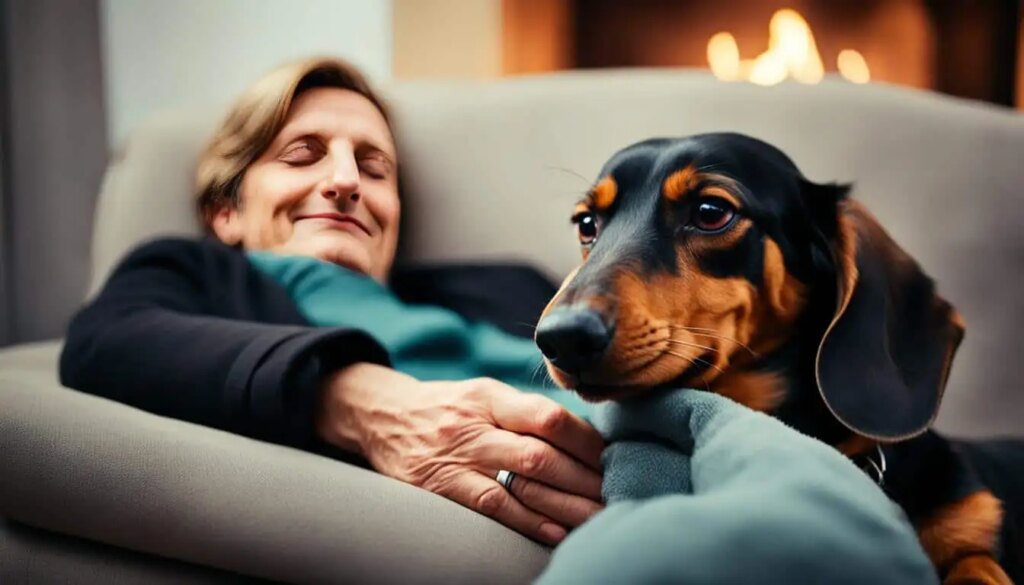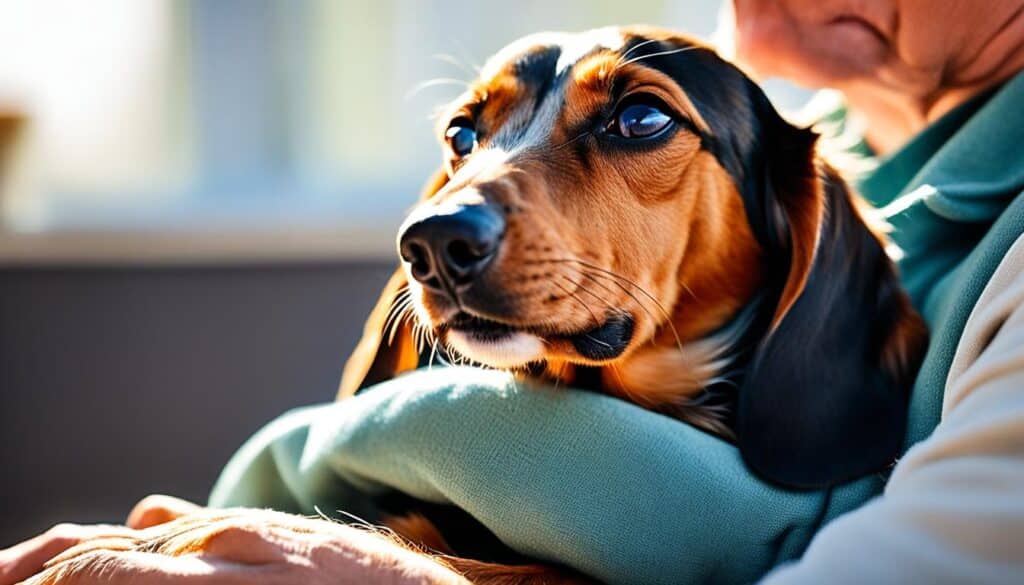Picture this: a cozy evening on the couch, nestled under a warm blanket, with a furry friend curled up beside you. For many dog lovers, this is the epitome of comfort and companionship. And when it comes to lap dogs, the image of a small, affectionate pooch snuggled in your lap often comes to mind.
But what about Dachshunds? Are these unique and spirited canines truly inclined to be lap dogs?
As a proud owner of a Dachshund myself, I can certainly attest to the joy and warmth they bring into our lives. Their distinctive long bodies, endearing expressions, and wagging tails make them irresistible. But when it comes to lap-sitting, every Dachshund has their own individual preferences.
In this article, we will delve into the cuddling habits of Dachshunds and explore whether they are naturally inclined to be lap dogs. We will uncover the factors that influence their behavior, understand the importance of bonding and trust-building, and provide you with tips to encourage and enhance cuddling experiences with your beloved Dachshund.
Key Takeaways:
- Dachshunds have varying preferences when it comes to lap-sitting and cuddling.
- Understanding bonding and trust-building practices can help encourage cuddling behavior.
- Dachshunds also require exercise alongside lap time to stay physically and mentally healthy.
- Respecting your Dachshund’s individual preferences is essential for a strong bond.
- With love and care, Dachshunds can bring immeasurable joy and companionship.
The Cuddling Habits of Dachshunds Uncovered
Dachshunds, like humans, have unique individual preferences when it comes to cuddling. While some Dachshunds are natural cuddle bugs and seek out every opportunity to snuggle up close, others may be more independent and less inclined to engage in close physical contact. Understanding these individual preferences can help Dachshund owners create a nurturing environment that promotes cuddling and bonding with their furry companions.
Individual Preferences for Cuddling
Each Dachshund has its own distinct personality and comfort level with cuddling. Some may prefer to be constantly by their owner’s side, seeking warmth and affection in their laps, while others may enjoy occasional snuggles but also value their personal space. It’s important for owners to recognize and respect their Dachshund’s boundaries and preferences when it comes to cuddling, ensuring a positive and enjoyable experience for both the dog and the owner.
Understanding the Bonding and Trust-Building Practices
Cuddling plays a significant role in bonding and building trust between Dachshunds and their owners. Regular cuddling sessions help strengthen the emotional connection and create a sense of security for the dog. Engaging in calm and gentle physical contact can also help alleviate separation anxiety and establish a deeper bond between the dog and its owner.
Trust-building practices, such as positive reinforcement training methods and consistent routines, contribute to a Dachshund’s willingness to engage in cuddling. When a dog feels safe and secure in its environment, it is more likely to seek out and enjoy cuddling experiences.
Dachshunds’ Need for Exercise Alongside Lap Time
While Dachshunds do make great lap dogs, it’s important to remember that they also have an innate need for exercise and physical activity. Incorporating regular exercise into their daily routine helps fulfill their natural instincts and release excess energy, making them more content and calm during lap time sessions.
Providing opportunities for Dachshunds to engage in physical activities, such as walks, playtime, and interactive toys, not only promotes their overall well-being but also enhances their comfort and relaxation during cuddling sessions.
Encouraging Cuddling: Tips for Dachshund Owners
- Start with short cuddling sessions: If your Dachshund is not accustomed to cuddling, begin with shorter sessions and gradually increase the duration over time. This allows them to become comfortable with the physical contact at their own pace.
- Offer rewards and positive reinforcement: Use treats or verbal praise to reward your Dachshund when they willingly engage in cuddling. This positive reinforcement helps associate cuddling with positive experiences, reinforcing their desire to cuddle in the future.
- Create a cozy and inviting environment: Provide soft blankets, pillows, or a warm lap for your Dachshund to snuggle on. Creating a comfortable and inviting space can encourage them to seek out cuddling opportunities.
- Respect personal boundaries: Always be mindful of your Dachshund’s cues and body language. If they show signs of discomfort or try to move away, allow them their personal space and try again at a later time.
- Be patient and understanding: Remember that every Dachshund is unique, and it may take time for them to develop a preference for cuddling. Patience, consistency, and understanding are key when encouraging cuddling behavior.
By understanding and respecting your Dachshund’s individual preferences, engaging in bonding and trust-building practices, incorporating exercise alongside lap time, and following these tips, you can create an environment that encourages cuddling and enhances the relationship between you and your Dachshund.
Are Dachshunds inclined to be lap dogs?
The question of whether Dachshunds are truly inclined to be lap dogs is a subject of interest for many dog owners and enthusiasts. While Dachshunds are often described as lap dogs, their inclination towards lap sitting can vary from dog to dog. Some Dachshunds thoroughly enjoy curling up on their owner’s laps, seeking warmth and companionship. Others may exhibit more independent tendencies and prefer to have their own space.
To better understand the lap dog tendencies of Dachshunds, several factors come into play. The breed’s history and lineage play a significant role. Dachshunds were originally bred as hunting dogs, which might explain their independent nature and self-sufficiency. However, over time, Dachshunds have become cherished companions and have adapted to domestic environments.

While some Dachshunds may naturally gravitate towards becoming lap dogs, others might require a bit more encouragement and training to foster lap sitting habits. A positive and supportive environment can help create a strong bond between the owner and their Dachshund. Regular interaction, playtime, and gentle encouragement can make lap sitting an enjoyable and rewarding experience for both parties.
It’s important to remember that every Dachshund is unique, and their lap dog tendencies may vary. Some factors that can influence their preference for lap sitting include their temperament, early socialization experiences, and individual personality traits. Patience and understanding are key when developing a close bond and encouraging lap sitting behavior.
In the next section, we will explore the temperament and compatibility of Dachshunds, shedding light on their transformation from hunters to companions. We will also discuss the intersection of size and personality, and provide insights into their training and exercise needs. Understanding these aspects will further enhance our understanding of Dachshunds and their lap dog inclinations.
Exploring the Dachshund Temperament and Compatibility
From Hunters to Companions: The Dachshund’s Transformation
Dachshunds have a fascinating history as hunting dogs, particularly for their ability to track and flush out burrow-dwelling animals like badgers. Over time, however, they have transitioned from being primarily working dogs to beloved companion animals. This transformation has had a significant impact on their temperament and behavior.
As hunting dogs, Dachshunds needed to be fearless, determined, and independent. These traits can still be observed in their modern counterparts. Dachshunds are known for their boldness, self-assuredness, and strong prey drive. They have retained their instinctive hunting skills, often being quick to chase after small animals or dig in the ground.
Despite their hunting background, Dachshunds have adapted well to the role of companions. They are incredibly loyal, affectionate, and form strong bonds with their owners. While their hunting instincts may still be present, they are generally friendly and social dogs that enjoy human company.

The Intersection of Dachshund’s Size and Personality
The size of a Dachshund plays a significant role in their personality and temperament. There are two main sizes of Dachshunds: standard and miniature.
Standard Dachshunds are larger and more robust. They tend to be more confident, assertive, and sometimes even stubborn. They have a higher energy level and may require more exercise and mental stimulation compared to their miniature counterparts.
On the other hand, miniature Dachshunds are smaller in size but not lacking in personality. They are often described as playful, affectionate, and outgoing. Miniature Dachshunds are known for their charm and adaptability to different living situations. They are generally more suitable for apartment living due to their size.
Training and Exercise Needs of a Dachshund
Training and exercise are essential for a Dachshund’s overall well-being and behavior. While they are intelligent dogs, Dachshunds can be independent and stubborn at times, which may require a consistent and patient training approach. Positive reinforcement methods, such as rewards and praise, work best with Dachshunds.
In terms of exercise, Dachshunds have moderate energy levels and require regular physical activity to stay healthy and mentally stimulated. Daily walks, interactive playtime, and mental enrichment activities are all beneficial for Dachshunds. However, it is important to avoid excessive exercise or activities that put strain on their long backs, as Dachshunds are prone to spinal issues.
Potential Behavioral Issues and Their Management
Like any dog breed, Dachshunds may develop certain behavioral issues that require management and training. Some common behavioral issues seen in Dachshunds are separation anxiety, excessive barking, and digging.
To address these issues, providing a secure and stimulating environment, proper socialization from an early age, and consistent training are essential. Additionally, seeking guidance from a professional dog trainer or behaviorist can be beneficial for Dachshund owners dealing with specific behavioral challenges.
Conclusion
In conclusion, the inclination of Dachshunds to be lap dogs varies from dog to dog. While some Dachshunds may love to cuddle and enjoy sitting on their owner’s laps, others may display less interest in close physical contact. It is important to understand and respect the individual preferences of each Dachshund.
Owners can foster a strong bond with their Dachshunds by engaging in bonding and trust-building practices. Spending quality time with their pets, providing affection, and positive reinforcement can help create a loving and secure environment.
Additionally, it is crucial to recognize the importance of exercise alongside lap time. Dachshunds need physical and mental stimulation to stay healthy and satisfied. Regular walks, play sessions, and interactive toys can help fulfill their exercise needs and contribute to their overall well-being.
In summary, while Dachshunds are often referred to as lap dogs, their lap-sitting tendencies may vary. By understanding their preferences, implementing bonding practices, and balancing exercise and affection, owners can nurture a strong bond with their Dachshunds and create a fulfilling pet-parent relationship.
